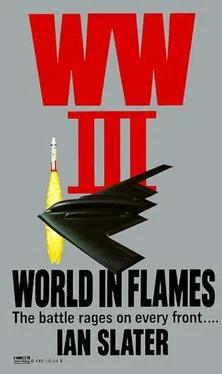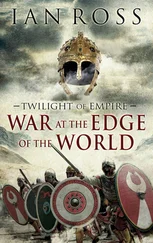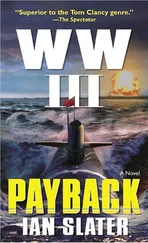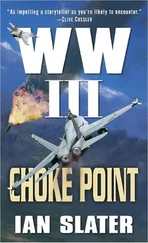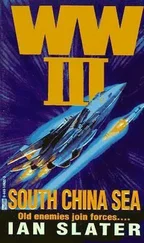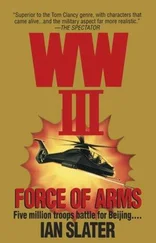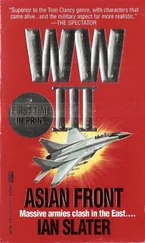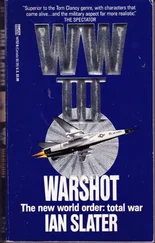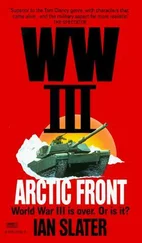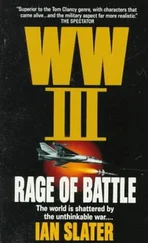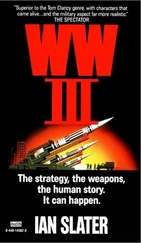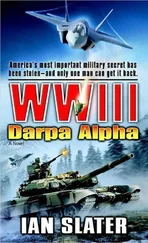Ian Slater - World in Flames
Здесь есть возможность читать онлайн «Ian Slater - World in Flames» весь текст электронной книги совершенно бесплатно (целиком полную версию без сокращений). В некоторых случаях можно слушать аудио, скачать через торрент в формате fb2 и присутствует краткое содержание. Год выпуска: 1991, ISBN: 1991, Издательство: Ballantine Books, Жанр: Триллер, на английском языке. Описание произведения, (предисловие) а так же отзывы посетителей доступны на портале библиотеки ЛибКат.
- Название:World in Flames
- Автор:
- Издательство:Ballantine Books
- Жанр:
- Год:1991
- ISBN:0-449-14564-6
- Рейтинг книги:5 / 5. Голосов: 1
-
Избранное:Добавить в избранное
- Отзывы:
-
Ваша оценка:
- 100
- 1
- 2
- 3
- 4
- 5
World in Flames: краткое содержание, описание и аннотация
Предлагаем к чтению аннотацию, описание, краткое содержание или предисловие (зависит от того, что написал сам автор книги «World in Flames»). Если вы не нашли необходимую информацию о книге — напишите в комментариях, мы постараемся отыскать её.
World in Flames — читать онлайн бесплатно полную книгу (весь текст) целиком
Ниже представлен текст книги, разбитый по страницам. Система сохранения места последней прочитанной страницы, позволяет с удобством читать онлайн бесплатно книгу «World in Flames», без необходимости каждый раз заново искать на чём Вы остановились. Поставьте закладку, и сможете в любой момент перейти на страницу, на которой закончили чтение.
Интервал:
Закладка:
As a result, the American rules of engagement now stated that all U.S. pilots could not engage before IFF had been established by “visual fix”—a radar blip insufficient to assume a Bogey, or unidentified aircraft, was in fact a “Judy”—an enemy plane. Even the normally swashbuckling Freeman, before he’d disappeared across the Yalu, had endorsed the rule, but the necessity of having to make a visual fix imposed a serious tactical disadvantage on the American pilots. It meant that the long-range missiles, such as the nine-mile-range infrared homing Sidewinder, which needed time — even though this was measured in milliseconds — to lock on to an enemy’s exhaust or side heat patch, couldn’t be used to anywhere near their full effectiveness. At shorter ranges, the missile could be evaded by the tight-turning MiGs before the Sidewinder had time to “lock on.”
For this reason, the Sparrow missile was preferred. Ironically it had a longer range at twenty-four miles than the Sidewinder, but did not require heat exhaust to lock on and could be fired from any angle. But at 514 pounds, it was more than twice as heavy as the Sidewinder, and this meant fewer missiles could be carried.
“Bogeys two o’clock high!” It was the wingman — right side of the finger-four formation of Tomcats — the four blips coming out of the northwest behind and to the right as the Tomcats headed southwest over the Yalu. The blips were fourteen miles away. The Tomcats’ leader had a choice to either break left, south, away from the Yalu into the U.S.- and-South-Korean-held North Korea, or to go north for a visible fix, with the possibility of engagement if the Bogeys turned out to be Judys. The Tomcats had already consumed half their fuel.
“Go for IFF,” announced the Tomcat leader, and the F-14s turned tightly, pulling seven Gs, Shirer already feeling the effect of his heart literally distending under the pull of the G forces, wishing now more than ever that he’d had the toast. Behind him, his radar intercept officer had gone to “warning yellow, weapons hold” status, his active radar frantically hipping and the Northrop TCS — long-range television camera set — unable to identify the blips because of heavy cumulus, which the blips were now entering.
The four Tomcats had split into two combat pairs, Shirer still on his leader’s left and back, covering him, the Tomcats’ wings now coming in from the extended, fuel-conserving position to the tight V for greater speed at the cost of increasing fuel consumption. Shirer heard the Pratt and Whitney turbofans screaming as he and the leader went to afterburner.
“Bandits!” It was the leader’s radar intercept officer, and now Shirer’s RIO was telling him that from the computer-enhanced radar cross-section image, the Bogeys were in fact Russian fighters. “Fulcrums,” he advised Shirer, “A’s.”
Shirer, still close to his leader, saw a puff of smoke, and the two Tomcats broke, leader to the right, Shirer to the left, the Soviet missile passing between them. The next instant Shirer’s RIO was yelling, “Tally-ho one! Behind us, behind us!” telling Shirer a Fulcrum had been sighted penetrating their cone of vulnerability. Shirer went into a knife-edged turn and dropped, the Fulcrum passing over him and down, Shirer slowing, trying to go into a “scissors,” trying to reverse fee situation, putting his Tomcat behind the Fulcrum.
“Master arm on,” said Shirer, readying to fire a Sparrow.
“We’re behind him, we’re behind him!” called the RIO.
“Centering up the T! Centering up the dot!” said Shirer.
The Fulcrum, on afterburner, was already two miles ahead, still on the Tomcat’s radar, the other Tomcats having broken up into individual dogfights with the remaining three Fulcrums.
“Fox One! Fox One!” Shirer announced, then felt the tug on the plane as the Sparrow missile streaked ahead, the Fulcrum now only 1.6 miles away.
“He’s climbing!” said the RIO. Then suddenly, “He’s gone.” The RIO’s voice was incredulous. “Shit! He’s gone!” His tone was one of utter astonishment.
“Can’t be!” said Shirer. “We had a lock on.”
“Yeah — but he’s gone, man.”
Sergei Marchenko was in a near-vertical, eighty-two-degree climb, going “up the wall” on afterburner in the plane that even Western experts acknowledged had “no unnatural positions.” After two seconds, he had climbed another two thousand feet.
Suddenly he reduced thrust to idle on the two eighteen-thousand-pound-thrust Tumanskys, bleeding off speed, the plane’s attitude a hammerhead stall/slide in the vertical plane — the effect of this on the enemy’s Doppler radar calculated to be one of utter confusion, for without relative speed measurement, no target would appear on the enemy plane’s screen.
Shirer remembered the Russian maneuver, reduced thrust, went into a climb, broke cloud, and glimpsed the Fulcrum still above him sliding backward into his HUD sight. It was only for a fraction of a second. Shirer’s thumb pushed the Vulcan button — the burst only a half second, but in that time, twenty-five of the machine gun’s twenty-millimeter bullets hit the Fulcrum’s spine, the burst finishing its run in the cockpit, the Fulcrum’s Perspex exploding in whitish-green fragments. The Fulcrum kept sliding, tail first, its number nine in front of the box jet intake and the slogan “Ubiytsa Yanki” —”Yankee Killer”—seen only briefly before the fighter quickly went into an uncontrolled spin, the big slab tail fins a gray blur, obscured momentarily by the sudden opening of the cruciform braking chute. But now the plane was burning, and in another second the chute was a black smudge against the snow of the Yalu’s foothills, the explosion as the Fulcrum hit, a silent orange blossom.
“Good kill! Good kill!” the RIO was shouting.
“Any pilot chute?” asked Shirer.
“Negative,” confirmed his RIO. “No chute!”
“Great! Now I can go back to the Bus. By this time tomorrow night, I’ll be heading back to Andrews.”
The RIO was perplexed; the only “Bus” he knew about was the reentry-vehicle dispenser used on intercontinental ballistic missiles.
By now the four Tomcats were too far apart and their fuel too low after the afterburners’ greedy consumption to regroup, and so they made their way individually back to Kapsan field south of the Yalu.
In Washington, President Mayne was sitting quietly behind the Oval Office desk as he and the four chiefs of staff, Security Adviser Schuman, and Press Secretary Trainor listened to the chief of naval operations.
“So, gentlemen,” Mayne asked, the migrane that had threatened him thwarted not only by medication but by sheer will. “What to do?”
“Tell the Russians,” said the CNO, Admiral Horton, “if they go nuclear, we’ll fire everything we’ve got.”
“Don’t by silly!” said Mayne.
The admiral was stunned, as were the other chiefs of staff and press aide Paul Trainor, though Trainor, with long experience in front of the press, did not betray his surprise. Adviser Schuman, however, was not surprised and sat holding his cane, calmly gazing down at the plush carpet, observing the intricate design of the new great seal of the United States at war, the eagle’s clutch of arrows in the right rather than the left claws.
“The president’s correct,” said Schuman. “You people were telling us only the other day, Admiral, that whatever their deficiencies, the Russians are infinitely better equipped to have at least a quarter of the population avail themselves of extensive nuclear shelters. We, however, are out to lunch as far as that’s concerned, because, as you correctly pointed out, gentlemen, my learned colleagues in Congress have long accepted Mr. Sagan’s view that a nuclear war is unwinnable. Never mind the limited radiation yield, for example, on our atomic shells, et cetera. Mr. ‘Billions and Billions’ and his disciples convinced us that civil defense was futile. Now we’re paying the price for our gullibility on that score. And because of that, the only thing we can really threaten them with is our submarine-launched missiles. We have a few ICBMs operational in the Midwest, but communications are so generally fouled up because of continuing sabotage, we cannot depend on any realistic coordinated or widespread missile offense from our land-based silos or from SAC.”
Читать дальшеИнтервал:
Закладка:
Похожие книги на «World in Flames»
Представляем Вашему вниманию похожие книги на «World in Flames» списком для выбора. Мы отобрали схожую по названию и смыслу литературу в надежде предоставить читателям больше вариантов отыскать новые, интересные, ещё непрочитанные произведения.
Обсуждение, отзывы о книге «World in Flames» и просто собственные мнения читателей. Оставьте ваши комментарии, напишите, что Вы думаете о произведении, его смысле или главных героях. Укажите что конкретно понравилось, а что нет, и почему Вы так считаете.
